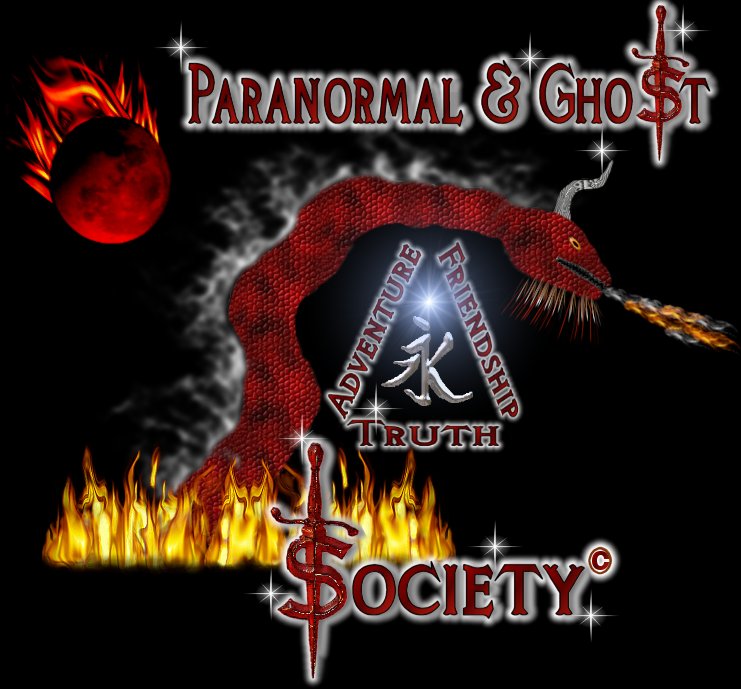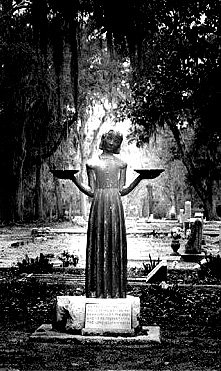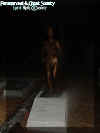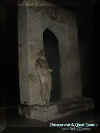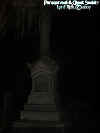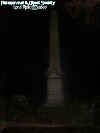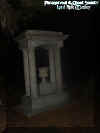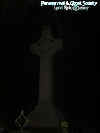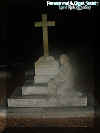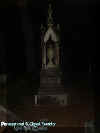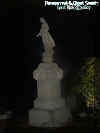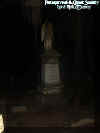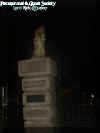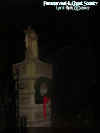|
|
||
|
Midnight In The Garden Of Good An Evil.......Bonaventure Cemetery You cannot visit Savannah Georgia without touring Bonaventure Cemetery. It has been quoted to be one of the top ten cemeteries in the country with a beautiful scenic view. Cemeteries a century ago were more then just a place for burial they were symbolism of different classes and historical achievements. They were places people could go and reflect. Unlike most cemeteries their is a rich history which surrounds this monumental place. Colonel John Mullryne and his wife Claudia Catell established their residence on what is Bonaventure Cemetery today in 1762. They had a 600 acres rural estate which was located on the Saint Augustine Creek about 3 miles from the Savannah Colony. The Mullrynes youngest daughter named Mary and her Husband Josiah Tattnall had two children born at the Bonaventure property in 1763 and named him John Mullryne Tattnall and in 1765 Josiah Tattnal Jr. This was an odd plantation since no crops were ever cultivated. Colonel John Mullryne did however plant live oak trees every 15 feet on each side of the roadways surrounding the state. In 1771 a fire broke out and burned the first plantation house. It was replaces with a brick mansion and considered to be one of the most classy structures in the Savannah province. In 1776 Royal Governor James Wright escaped his captors in the Revolutionary war and hid out at the mansion. He then left here to Cockspur Island and eventually Englad. The estate on St. Augustine Creek became a landing for the French and Haitan troops under count Charles d'Estaing in 1779 and the mansion was used as a hospital during the Siege of Savannah. Nobody knows for sure but the French troops were very wounded, bloody and very much defeated. Some say many of these troops were buried at Bonaventure with no markings. When that battle ended many of the French troops departed from Bonaventure. Below in the quotes is another mystery about a famous war hero named Pulaski! "Bonaventure is somewhat involved in the conflicting theories about what happened to Count Casimir Pulaski's body after he died from wounds suffered in the unsuccessful siege at the Springhill Redoubt. One story is the Polish nobleman was taken aboard a French ship, where he died and was buried at sea. Another school of thought is that he was buried at Greenwich Plantation, which was a neighboring plantation to Bonaventure, and is still there. Yet a third belief is that Pulaski's remains were disinterred from Greenwich in 1854 and reburied under the Pulaski Monument in Monterey Square. This seems to be the more accepted explanation. Only time and DNA analysis will tell." When the revolutionary war did break out and ended both Josiah Tattnal and John Mullryne took a turn for the worst. Both men pledged their loyalties to Englands King George III which resulted in their arrest and banishment from GA. They were given 60 days to leave the colony or they would be arrested transported to Britain. They did not leave and that is how the property became liberated and auctioned. When I walked around the grounds I tried to visualize a pretty lady and me sitting under an oak exchanging innocent love. That is the energy that this place gives its full of beauty and love. Sadly in 1782 the Bonaventure Estate was confiscated by the Revolutionary government and sold at a public auction to a John Habersham which is buried at Colonial Cemetery we even have a photo of his plaque. John Habersham resold the property in 1785 to Josiah Tattnal Jr and Harriett Fenwick the wife. Josiah Jr had returned to GA to fight for the colonies which would leave to him becoming Governor eventually. It was rightfully theirs so buying it back just tells you how much this family adored the estate. They had nine children from 1786 to 1801 and buried four of them on the Bonaventure grounds. They shortly passed away later as Harriett died in 1803 and Josiah died as the governor in 1804 a year later. The orphans were raised in London by their grandparents. The second mansion was destroyed nobody knows the date they just know it was after 1803 to 1817. Edward Fenwick and Josiah Tattnal III were both sons of the governor resided at Bonaventure as they inherited the estate. All they could see is ruins of the house and tree lined roadways. Rumor has it that Josiah Jr was having a dinner party at Bonaventure when the mansion caught fire. Josiah JR insisted that his guest finish the dinner and so his servants moved everything out to the yard. The guest sat their watching the great house burn to the ground. They shared history as it burned out of control. Rumor has it that visitors and even caretakers can still here the clinks and clatters of tableware and laughter from the nearby dinner party when in fact nobody is in the cemetery. In 1846 the property was sold to a Peter Wiltberger who had full intent of developing the land into a public cemetery in Thunderbolt which is just outside of Savannah. During that time Josiah Tattnall III became a commodore in the confederate Navy just before the civil war. During this time Wiltberger agreed to maintain the land providing burials for the Tattnal family and his own. He paid at that time 5000 dollars for the property. Up until 1907 Bonaventure was called Savannah Evergreen Cemetery. The area may have lost its mansion but it has not lost its massive live oaks which its limbs covered in Spanish moss overhang every roadway within the cemetery. Some of them are as old as 250 years. Live oaks were planted because they are durable and bend rather then break this is a very hurricane resistant sort of tree. In 1804 a hurricane struck and the trees remained in tact. Just as the second worst one to hit was the Great Sea Islands hurricane in 1893. In 1824, 1854, and 1884 there were other storms. The trees all still remain so they are an important piece of history. They are even registered on the GA Landmark and Historic Tree Register. Today the site is a cemetery which is very peaceful sits in a old historic neighborhood and rest right on the scenic bluff of the Wilmington River. In 1846 it was purchased as a private cemetery and became public in 1907. You can still be buried here as its a very large area it sure would be a place Id love to be buried at its gorgeous here. The cemetery has many sculptures, vaults, crypts, crosses, tombstones, statues and very nice works of art. The cemetery did not become famous till John Berendt's came out with a book called Midnight In The Garden Of Good and Evil which was published. That book was then made into a movie with the same title by Clint Eastwood which put the Cemetery in the spotlight and made Savannah a MAJOR tourist destination. Even though the area was now a cemetery burials started here in the 1700s. Over a century ago if you lived on the property you were buried on the property that is just how it went. The book has a photo on the cover of the cemetery as most of the best seller takes place on the grounds of this cemetery. Not only is the cemetery a place of a book, plantation, historic oak trees etc. It is also the place of many famous individuals buried here. Further below is a listing of some notable burials from the historical society. It is for educational use only I did not gather the information only sharing it. When this cemetery opened up alot of families moved there loved ones here. The first monument to be put in at Bonaventure was that of the Jones family in 1848. Jones was moved from Colonial Cemetery to this location. Bonaventure was large...spacious..had a nice view and people took burial here serious. The first interment that was not a removal from elsewhere was Susan Green Wiltberger the wife of Peter who was buried here in 1849. Laurel Grove North was sold out so Bonaventure cemetery had room for growth with its 70 acres at the time. Peter owned however 600 acres in the area and eventually his son would take over in maintaining the area. Bonaventure has been maintained for almost two centuries as the families who owned the property were notable figures in Savannah. The name Bonaventure means "GOOD FORTUNE". Today many various individuals are buried here such as well known poet Conrad Aiken, Noble Jones who arrived with Oglethorpe in 1733 and became the owner of the Wormsloe Plantation....lets not forget the very popular Lyricists of the 20th century Johny Mercer who is also a guest of Bonaventure. Its a special place for me it was a dream come true I spent many years observing articles on this place wondering when I would get my opportunity to walk on its grounds late at night. Its a gloomy place and sits right out on a bluff which I stood at the edge on that is true beauty. I will not lie to my members something pushed me in that cemetery it was more like something put its arm around me when I stood on the edge. It is a powerful place being alone here at night not knowing where I am going walking around its gardens was the ultimate high for me. Rumor has it that the cemetery has ghost dogs which growl and even chase others out., the ghost of Gracie Watkins who died at 6 years old and is often seen at various locations such as her fathers hotel. People will hear her crying some have seen her statue tear blood from the eyes. They are usually seen when others remove objects from the statues hand that were left there. So its definitely an exciting place to visit and some of the burials here are amazing angel statues, marble platforms, giant crypts, graves under oak trees and even civil war solders. © By Lord Rick Also check out this video of the cemetery I did not do it but its an amazing place showing you photos of places I traversed through see if you recognize a couple of spots I took photos at. There are at least four parts in this movie where I stood at. Click Here: Youtube video of Bonaventure Cemetery & Click Here: Bonaventure Cemetery Information
I was starving, shivering, feet were killing me, sick and had a heat rash on my legs. I was hungry and then out of nowhere the Lord seen the golden arches and thus I called this heaven as I walked up to the drivethrough and demanded in the ghetto a hamburger. The only white male working there looked at me smiled and put an apple pie free in the bag and that is the power of the Lord...Lord Rick that is! Peace to all those members who donated for the Savannah trip bless you Jill and Anna you both mean the world to me. :) This is a fact I lost my hat in a tree I believe you and me spooky things happen even when their not supposed to be so spooky! The Entrance with its wreath is a wrought iron gate graced by two columns and statues. The cemetery has many statues I did not even capture close to as many as I seen in the moonlight just an amazing place!
|
||
|
|
|
